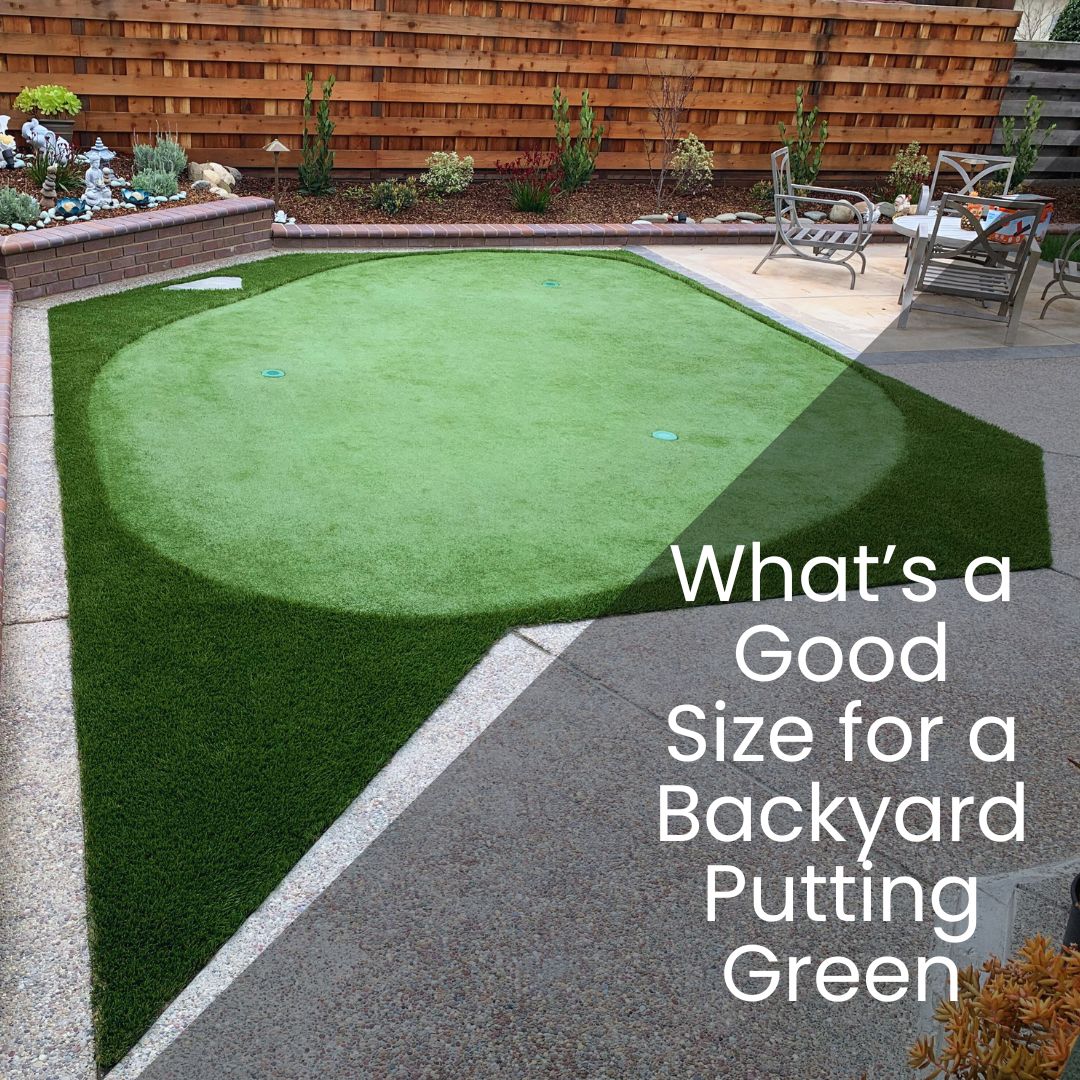The Perfect Fit: Choosing the Ideal Size for Your Backyard Putting Green
Ever dreamed of sinking putts in your own backyard? You’re not alone. At Realturf USA, we’ve helped countless golf enthusiasts turn that dream into reality. But here’s the million-dollar question: What’s the right size for your backyard putting green? Let’s tee off and explore this crucial aspect of backyard golf paradise design.
Why Size Matters for Your Backyard Putting Green
Size isn’t just about how much space you can spare. It’s about creating a practice area that enhances your game and fits seamlessly into your lifestyle. Here’s why getting the dimensions right is key:
- Practice Versatility:
- A well-sized green lets you practice a variety of putts, from nail-biting 3-footers to challenging 30-foot lags. Different distances and angles help you develop a more comprehensive putting skill set.
- A longer green allows you to work on your distance control, while a wider green gives you the opportunity to practice breaking putts.
- Realism:
- The goal is to replicate the feel of a real course green. Too small and you’re just putting on a fancy mat. Too large and you might as well be at the golf club.
- A properly sized green can mimic the undulations, speeds, and challenges you’d face on an actual course. This realism is crucial for transferring your practice gains to your on-course performance.
- Space Harmony:
- Your putting green should complement your yard, not dominate it. It’s about creating a balance between your golfing ambitions and your overall landscape design.
- A well-integrated putting green can become a beautiful focal point of your outdoor space, enhancing both functionality and aesthetics.
- Budget Sense:
- Larger greens cost more to install and maintain. Finding the sweet spot between size and budget is crucial for long-term enjoyment.
- Remember, the initial installation is just part of the equation. Ongoing maintenance, potential repairs, and even your water bill if you opt for natural grass are all influenced by the size of your green.
- Skill Level Considerations:
- Your current golfing ability and future goals play a big role in determining the ideal size. Beginners might be satisfied with a smaller green focused on basic skills, while more advanced players may need a larger, more complex setup to continue improving.
- Multi-Functionality:
- Consider how the putting green might serve other purposes. A larger green could double as a unique entertaining space for non-golfing gatherings, while a smaller one might leave room for other backyard activities.
Typical Sizes for Backyard Putting Greens
While every yard is unique, here are some common dimensions we’ve found work well:
- Cozy Corners (150-300 square feet):
- Perfect for: Urban dwellers, beginners, or casual players
- What you can do: Practice basic straight putts and slight breaks
- Design features: Often includes 1-2 hole locations and gentle slopes
- Suburban Sweet Spots (300-500 square feet):
- Ideal for: Average suburban yards, intermediate players
- What you can do: Vary putting lengths, practice moderate undulations
- Design features: Usually incorporates 2-3 hole locations, more pronounced breaks, and potentially a small fringe area
- Backyard Bonanzas (500-800 square feet):
- Suited for: Spacious properties, serious golfers
- What you can do: Multiple hole locations, significant contours, basic chipping
- Design features: Often includes 3-4 hole locations, varied terrain, a dedicated fringe, and sometimes a small bunker
- Golf Guru’s Paradise (800+ square feet):
- Best for: Luxury homes, golf enthusiasts, multi-purpose entertainment areas
- What you can do: Full short-game practice, including pitching and bunker play
- Design features: Multiple hole locations (4+), significant undulations, large fringe areas, often includes bunkers and chipping areas
How to Decide on Your Starting Size
Choosing the right size isn’t just about measuring your yard. Here’s a comprehensive guide to help you decide:
- Assess Your Space:
- Measure your available area: Use a tape measure or laser measuring tool to get accurate dimensions of your potential green space.
- Consider views from your house and patio: Think about how the green will look from different vantage points in your property.
- Think about other yard uses: Balance your golfing needs with other activities like gardening, kids’ play areas, or outdoor dining.
- Evaluate sun exposure: Ensure the location gets adequate sunlight for grass growth if using natural turf or to prevent moss and algae for artificial turf.
- Define Your Goals:
- Skill improvement: Are you aiming to lower your handicap or just have fun with friends?
- Practice variety: Do you want to practice a variety of putts or focus on specific distances?
- Short game focus: Is chipping or pitching important to include in your practice area?
- Usage frequency: How often do you plan to use the green? Daily practice might justify a larger investment.
- Consider Your Budget:
- Initial costs: Remember, cost increases with size. Get quotes for different size options.
- Long-term expenses: Factor in maintenance costs, potential repairs, and any increases in water or energy bills.
- Return on investment: Consider how a putting green might affect your property value.
- Visualize the Layout:
- Create a scale drawing: Sketch a rough design of your yard on graph paper.
- Use technology: Try using landscape design apps or software to create a digital mockup.
- Physical layout: Use string or garden hoses to outline potential green sizes in your actual yard.
- Consider flow: Think about how the green will integrate with existing pathways and features.
- Think Long-Term:
- Future landscape changes: Will you be adding or removing other features in your yard?
- Family needs: Consider how your family’s use of the backyard might change over time.
- Golfing evolution: Will your golfing needs or skills likely change significantly?
- Maintenance capabilities: As you age, will you be able to maintain a larger green?
- Consult with Experts:
- Seek golfer input: If possible, get opinions from golf pros or experienced players.
- Check local regulations: Ensure your plans comply with any HOA rules or local ordinances.
- Consider Climate and Environment:
- Local weather patterns: How will your climate affect the green’s usability and maintenance?
- Drainage needs: Assess how different sizes might impact your yard’s drainage.
- Environmental impact: Consider water usage and chemical treatments if opting for natural grass.
Making the Most of Limited Space
Don’t let a small yard crush your putting green dreams. We’ve created stunning compact greens that prove size isn’t everything. Here’s how we maximize minimal space:
- Multi-Level Designs:
- Use slopes to your advantage: Create tiered greens for added challenge and visual interest.
- Incorporate retaining walls: These can add character and define the green’s space.
- Creative Shapes:
- L-shaped greens can fit snugly into corners: Maximize awkward spaces in your yard.
- Curved designs can work around existing features: Integrate the green with current landscaping.
- Asymmetrical layouts: These can add interest and challenge to smaller spaces.
- Dual-Purpose Areas:
- Incorporate the green into your patio design: Blend leisure and practice spaces.
- Use artificial turf that can double as a lounging area: Choose a turf that’s comfortable for both putting and relaxing.
- Removable hole cups: Allow the space to transition easily between golf and other uses.
- Vertical Elements:
- Add a hitting net for full swings: Maximize practice options in limited space.
- Install a small water feature: Add ambiance and a unique putting challenge.
- Use wall space: Incorporate a scoreboard or club rack to save ground space.
- Optical Illusions:
- Use fringe areas creatively: Wider fringes can make the green appear larger.
- Incorporate mirror elements: Strategically placed mirrors can create an illusion of more space.
- Play with perspective: Design the green to appear longer from your primary viewing angle.
- Modular Designs:
- Create portable sections: Design parts of the green to be movable for flexibility.
- Expandable options: Start small with the ability to add sections later.
- Seasonal adaptability: Design elements that can be changed to keep the space interesting year-round.
Ready to Find Your Perfect Fit?
Choosing the right size for your backyard putting green is a balance of space, budget, and golfing ambitions. But you don’t have to figure it out alone. Our team at Realturf USA has the expertise to help you design the ideal putting green for your unique situation.
We’ll assess your yard, listen to your goals, and create a custom design that maximizes your space and budget. Whether you’re dreaming of a compact practice area or an expansive short-game paradise, we’ve got you covered.
Call us at 773-517-7798 or message us today for a free consultation!

